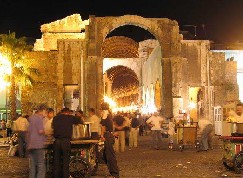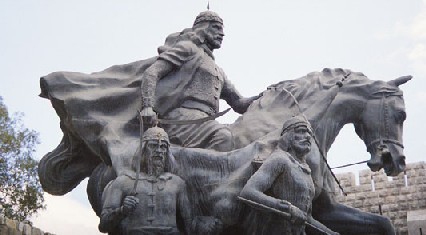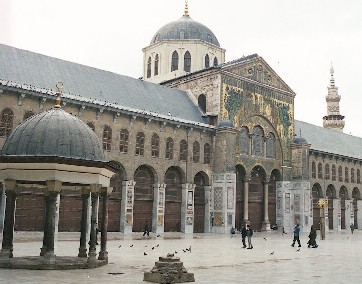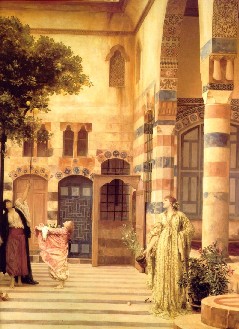|
Damascus
is the world’s oldest continuously inhabited city. The
only other city that might contest this fact might be
Aleppo, 360 kms to the north. A center of life from as
early as 5000 BC., Damascus was a meeting place of many
different caravan routes and one of the greatest market
places of history. It was mentioned in many cuneiform
tablets dating back to 3rd millennium BC. found in Mari
and Ebla archives. Amorite settlement began around late
3rd millenium. It came into Egyptian sphere
of influence and was mentioned in the Amarna archives
14C. BC. It went under Arameans, Assyrians, and Persians
control before it was conquered by Alexander the Great
in 333 BC. , marking a turning point in the history of
Damascus: the beginning of an age of classical
civilization in this area that lasted until 630 A.D. In
its long history of domination by outside powers, it was
the first time that Damascus had come under Western
control. Damascus went under wave of western influence
marked by the Greeks, Romans and the Byzantines. It
became Islam’s first great capital under the Umayyad
Caliphs during 7-8 C.
As the chief city
of the Middle East and Headquarters of Mu’awiyah,
Damascus was the natural choice for the capital of the
new Islamic Empire - the Omayyad Caliphate. These were
the glorious days of Damascus, when the Great Omayyad
Mosque was built, along with numerous palaces and
villas. The great mosque was initially shared with the
Christians when the Arab Army conquered Damascus. For
more than sixty years, both religions perform their
rituals side-by-side.
However, Caliph
al-Walid ibn Abdul Malek decreed in 705 A.D. that he
shall build the greatest mosque ever - one “whose like
was never built before, nor will ever be built after.”
And he took 10 years and 11 million gold dinars to build
his mosque. The result is a marvelous monument - a
grand prayer hall with mosaic walls (very beautiful
mosaic arrangements depicting buildings and landscapes -
so unlike most mosques one sees around the world where
the only art appears to be geometric patterns), a huge
marble courtyard and a few tall minarets.
What impresses
there is not merely the grandeur but the sense of
peacefulness that one finds inside. That aside,
visitors should be aware that this is a very special
holy place, as the shrine of St John the Baptist, who
the Muslims consider as Prophet Yahya, lies within the
prayer hall. Round the shrine were many people, kissing
and praying softly in front of the shrine, where St
John’s head (he was decapitated by the Romans) was kept.

Near the Omayyad
Mosque were mausoleums of two great Middle Eastern
sultans of the Age of the Crusaders - Salah Ad-Din,
founder of the Ayyubid Dynasty, and Baibars I, the most
eminent of the Mamluk sultans. Each of the mausoleums
is small and almost insignificant architecturally.
Salah Ad-Din (which means "Righteousness of the Faith”),
commonly known as Saladin in the West, was an army
commander under the ruler of Aleppo. Through his
military genius and shrewdness, he conquered Damascus
and then took over Egypt. When Nureddin died, he took
over the throne and within a short time, built an empire
which included Egypt, Palestine, Syria and northern
Mesopotamia. After uniting the Muslim territories, he
turned his target to the Crusader Kingdom of Jerusalem.
At the Battle of Hattin on July 4, 1187, Salah Ad-Din
routed the Crusader Army, capturing the King of
Jerusalem and his lords. By October 1187, his troops
marched into the Holy City of Jerusalem, ending 88 years
of western rule, and unlike the standards of the days,
he did not celebrate his victory with a standard
bloodbath of Christians. And it was this civilised act,
together with many other events of chivalry that made
Salah Ad-Din legendary in the Western world.
The old city was
defended against enemies by means of a fortified wall
and a powerful citadel. The Wall was built in the Roman
era with large, tapered stones. It was oblong in shape,
designed in the manner of Roman military camps, cities,
and fortifications. There are Eight gates in it: Bab
Sharqi, Bab Al-Jabieh, Bab Keissan, Bab al-Saghir, Bab
Tuma, , Bab al-Faradiss, Bab Al Faraj and Bab Al Salam.
The main thoroughfare traversed the city from Bab al-Jabieh
to Bab Sharqi; on both sides there were Corinthian
columns, and cross it numerous triumphal arches. But
this thoroughfare has been submerged over the years to
about six metres underground, and has been superseded by
Souq al-Tawil of Midhat Pasha, under which are
occasionally discovered some Roman columns, especially
when road works are in progress.
One such
discovery was made in 1950 when a triumphal arch was
found at Bab Sharqi, brought up to street level, and
re-erected after its restoration was completed.
At the time of
the Islamic conquest in 635 A.D., the wall was still
solid and impregnable, so the two Muslim leaders, Khaled
ibn al-Wlid and abu Obeida ibn al-Jarrah, entered the
city through Bab Sharqi and Bab al-Jabieh respectively.
Thus the wall was preserved, and remained intact
throughout the Omayyad era. But when the Abassids
stormed Damascus in 750 A.D., they destroyed large parts
of it. It began to deteriorate over the years so much,
so that it became oval in shape. But it was partly
restored and reinforced at the time of the Nourites and
Ayoubites, in order to withstand the attacks of the
Crusaders. During Ottoman rule, however, it was
neglected altogether, and some masonry was removed for
use in other buildings; later on, numerous houses were
built upon the greater expanse of it.

The old covered
souqs of Damascus have a unique flavour you can savor
with eyes closed. As you walk about in the warm darkness
of these streets with their fragrant scents, spices, and
colourful merchandise spilling out of the shops onto the
pavements, you enter the strange world of exotic legend.
The most famous of these is Souk Al Hamidieh, built
in1863, by the Ottoman Sultan Abdul-Hamid, after whom
the souq was called. It is covered with high iron
vaulting, so old that sun rays filter through it into
the darkness of the souq. The shops here sell everything
from tissues to leather-work, from sweets and ice-cream
to exquisite handmade brocades, mosaic, and copper
inlaid with silver.
That area has
many other souqs, mostly specialized ones. Souq Al
Darwishieh was built by Darwish Pasha in 1574. Its
entrance is at the end of Souq al-Hamidiyeh just outside
the Omayyad Mosque. Its shops are filled with local
embroidered cloths, perfume essence, and tailoring and
sewing requisites. Here, too, a number of old khans have
been converted into shops, best known for their cloaks,
capes, mantles, shawls, and "galabiyas". Most
interesting of these clusters of little shops is an old
bath called al-Qishani.
Souq al-Harir
(silk) leads to yet another souq called al-Khayatin
(Tailors) which was founded by Shamsi Pasha in 1553; a
multitude of shops here sell woolen and material for
men's clothing. Hundreds of celebrated tailors of
traditional wear used to work here in the past. Between
these two souqs stands the mosque and tomb of the Muslim
leader Nureddin ibn Zenki. The mosque was erected in
1173, and is distinguished by a dome of unequalled
beauty, and interior and exterior designs of unique
originality. Also between the two souqs stands Madrassat
(school) Abdallah al-Azem, constructed in 1779, during
the Ottoman period, which has also been converted into a
cluster of small shops for traditional crafts
Souk Al-Bzourieh
extends between Souq Midhat Pasha and the Omayyad Mosque
and is famous for, medicinal herbs, and confectionery.
In the middle of
this souq stands a bath (one of the two hundred public
baths) which has been in continuous use from the twelfth
century. Here, too is the celebrated khan of As'ad Pasha
built by the owner of al-Azem Palace in the
mid-nineteenth century; it is now being converted into a
hotel.
Another little
souq branches out of al-Bzourieh; this is Souk Al Sagha
(Goldsmiths Market), where an endless variety of
hand-made jewellery is sold; the southern entrance to
the Omayyad Mosque overlooks this glittering little souq.
 
Those who can
resist shopping, at least at first, should wade farther,
to the triumphal arch that marks the remains of the
Temple of Jupiter, on a site that has housed sacred
enclosures for more than 3,000 years and ended up as a
site to the majestic Umayyad Mosque, which so far
survived more than 1,200 years of invasions,
earthquakes, fires and Mongol sackings. Another
important palace that must be visited by all Damascus
visitors is the Street Called Straight, a major
thoroughfare since Hellenistic times, and featured in
biblical tales of St. Paul's conversion to Christianity.
Straight Street also marks the best route to the Bab
Sharqi, at the old city's eastern edge, in a quarter
that has a cluster of good restaurants. It is here that
old Damascene houses may be most easily glimpsed, along
the street leading to the Chapel of St. Hanania, on a
site where Paul reputedly took shelter. Visitors are
free to peer into many courtyards, and in some houses,
small shops offer Damascus's most famous wares,
including the brocade and inlaid wooden boxes.
The Straighty
Street, which is now hardly straight, was mentioned in
the bible. And who commented on that? Mark Twain
himself:
“The street
called straight is straighter than the corkscrew, but
not as straight as a rainbow. St Luke is careful not to
commit himself; he does not say it is the street which
is straight, but `the street which is called straight.’
It is the only facetious remark in the Bible, I
believe.”
Mark Twain, The
Innocents Abroad, 1869
Old Damascus has
maintained a lifestyle that emphasizes seclusion,
beauty, and family togetherness. In old Damascus, each
home, regardless of size, is conceived as a private
paradise. In an Old City house, the courtyard - or two
or three, depending on the owner's wealth - is typically
a secret garden of damask roses, citrus trees, jasmine,
and gurgling fountains in summer. Surrounding the
courtyard are two floors of living space, the upper
level used in the winter months. The lower level
includes open reception halls with arabesque and rococo
paneling on ceilings and walls.
Wealthy Syrian
businessmen have bought some 40 traditional Arab homes -
jewel boxes of friezes and frescos, marble and mosaic -
and converted them into restaurants with trendy names
such as Oxygen and Neutron. The effect on the old
quarters has been moderate. However, with rapidly
increasing numbers of visitors, the authorities have
stated to give the matter due attention and has
restricted any project that changes the face of the old
city. |
